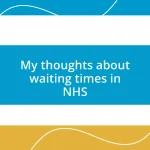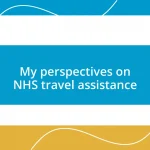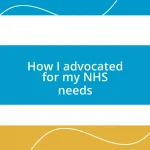Key takeaways:
- The NHS cost structure is complex, influenced by variables like tariffs, resource costs, and overheads, making it essential for patients to understand the bigger picture beyond just hospital bills.
- Cost transparency empowers patients to make informed decisions, promotes accountability in healthcare facilities, and enhances trust in the NHS system.
- Accessibility to NHS cost information through digital tools and open discussions with healthcare providers can significantly improve patient decision-making and lead to better healthcare outcomes.

Understanding NHS cost structure
The NHS cost structure is quite complex, blending fixed and variable costs that can be confusing at first glance. I remember when I first dived into this topic; it felt like unraveling a ball of yarn—each strand representing different elements like staffing, equipment, and facility management. Have you ever wondered why your local hospital sometimes seems stretched for resources despite significant funding?
One of the intriguing aspects of the NHS is how costs can vary from one hospital to another, even for the same procedure. I once experienced this firsthand when two friends underwent the same surgery at different facilities and received vastly different bills. Can you imagine the frustration of navigating those discrepancies, especially when it comes to understanding what you’re actually paying for?
Moreover, the NHS encompasses costs that aren’t immediately visible, such as community services and preventative care. It struck me that many people overlook these elements when considering the overall cost, which can lead to a skewed perception of value. Isn’t it essential for us to recognize the broader picture instead of just fixating on hospital stays or surgery costs? Understanding this holistic view can make a significant difference in how we advocate for and utilize NHS services.

Importance of cost transparency
Cost transparency in the NHS is vital for fostering trust between patients and the healthcare system. When patients understand the costs associated with their care, they can make informed choices. I recall a time when a friend of mine hesitated to seek treatment because she was unsure of the financial implications. Had she known the true costs upfront, I believe she would have acted sooner, potentially benefiting her health.
Understanding NHS costs also empowers patients to compare services and seek the best options available to them. I’ve found that by having access to cost information, I could weigh my choices more thoughtfully. Remember the last time you saw a hefty bill after a procedure? Knowing the specifics of what you’re paying for can soften the blow and help you feel more in control.
Additionally, transparency promotes accountability within the NHS itself. Facilities that openly share their cost structures are likely to be more diligent in managing expenses and improving efficiencies. For me, it’s about reassurance. When I see a healthcare provider being open about their costs, it solidifies my trust in the services they offer. It really makes one ponder: wouldn’t we all prefer a system that places affordability and honesty front and center?
| Aspect | Impact |
|---|---|
| Empowerment | Informed decision-making for patients |
| Comparison | Ability to evaluate treatment options effectively |
| Accountability | Encourages healthcare facilities’ responsibility |

Key components of NHS pricing
The key components of NHS pricing revolve around various factors that ultimately impact the cost of healthcare services. I remember when I first started understanding these components; it felt a bit like piecing together a puzzle. I’d sift through layers of information regarding tariffs, which are the prices set for specific treatments, and how they vary depending on patient needs and service types. This variability struck me as both frustrating and fascinating, as it reflects the complexity of individual healthcare requirements.
Let me break it down further with some essential components to consider:
- Tariff Structures: These are predetermined prices for services that depend on the kind of treatment, patient needs, and sometimes even geographical location.
- Cost of Resources: This includes everything from staffing costs to medical supplies and equipment needed for procedures.
- Overhead Expenses: Facilities like hospitals have ongoing costs such as rent, utilities, and maintenance, all of which contribute to pricing.
Understanding these components not only clarifies why certain services may cost more than others, but it also highlights the importance of comprehensive care. For instance, I recall a time when I needed a routine check-up that unexpectedly led to a series of tests. It was eye-opening to see how the added procedures affected the overall cost, reminding me of how healthcare isn’t just about single appointments or treatments. Each piece plays a crucial role in the bigger picture of NHS pricing, urging us to think beyond immediate expenses and consider the long-term value of our health investments.

Tools for accessing NHS costs
When it comes to accessing NHS costs, several digital tools have emerged that can make the process simpler and more transparent. For example, I recently explored the NHS website’s price list for common procedures—it’s quite accessible. I found it incredibly useful to see a rough estimate right at my fingertips, giving me a clearer sense of what to expect financially before any treatment. Can you remember the stress of uncertainty about costs? Having this data available transformed my experience from anxious to informed.
Another resource I came across is the NHS Price Information Service, which allows patients to compare costs across different services and providers. I recall using this tool when I was considering elective surgery; it led me to some unexpected findings about pricing variations in my area. It made me think about how often we may accept costs without question. By comparing prices, I was better positioned to discuss options with my healthcare provider, which not only eased my mind but also empowered me in my healthcare choices.
For those who enjoy a more hands-on approach, apps like Healthwatch provide valuable insights and feedback from other patients. I remember downloading one of these apps and being surprised by how much community feedback could influence my decisions. It felt reassuring to see real-life experiences of others regarding the cost and quality of their care. Knowing I wasn’t alone in navigating these complexities offered a sense of solidarity while exploring my options. What about you? Have you found any tools that made your healthcare journey easier to navigate? Sharing personal insights can be incredibly beneficial, creating a richer understanding for all of us.

Challenges in NHS cost disclosure
The challenge of NHS cost disclosure often lies in the inherent complexity of the pricing structures. I remember how bewildered I felt while trying to compare the costs of similar treatments across different hospitals. It seemed almost like trying to decipher a foreign language! The variation in tariffs made it clear that understanding the true cost of care requires deep insight and, unfortunately, a lot of time.
Moreover, the lack of standardized information can hinder patients’ ability to make informed decisions. When I embarked on choosing a suitable provider for my treatment, I noticed how the same service could vary in cost drastically depending on where it was performed. This inconsistency left me wondering how many patients make choices based solely on convenience rather than understanding the underlying costs. Isn’t it a bit unsettling to think about how this could impact someone’s health choices?
Lastly, the frequent updates and changes in pricing models further complicate the situation. I recall a moment when I checked a price just a few weeks before a planned appointment, only to find it changed significantly. It made me feel frustrated and anxious, pondering how many people might end up feeling blindsided by unexpected expenses. How can we navigate these waters effectively? It seems that without better communication and transparency from the NHS, many of us will continue to encounter challenges in understanding healthcare costs.

Improving patient decision making
Improving patient decision making is essential for navigating the complexities of NHS costs. I remember when I was deciding on a treatment plan, and I felt pretty lost. I wasn’t just looking at the medical aspects; I needed to consider financial implications. Realizing that I could consult the NHS cost data beforehand made a huge difference—it felt empowering to weigh my options knowledgeably, rather than making an uninformed choice that could lead to financial strain later.
One thing that really struck me was how discussing costs with my healthcare team opened up new avenues for my decision-making. I once had an appointment where I felt comfortable enough to ask about the pricing of different procedures. The provider was more than willing to break it down for me, and we ended up having a constructive dialogue that I hadn’t expected. It made me wonder: how many other patients might be too hesitant to ask those questions? Having transparent conversations turns what can be an intimidating experience into a collaborative one, enhancing our ability to make informed choices.
Lastly, I’d love to emphasize how sharing experiences can equip patients with better insights. After I shared my story in a community forum, I started receiving feedback from others that piqued my interest. Some had encountered similar situations, while others offered tips based on their research. The more we communicate with each other, the more we realize that navigating NHS costs doesn’t have to be a solo journey. Doesn’t it feel uplifting to know that we can lean on one another for knowledge and support? After all, informed decisions often lead to better outcomes in both health and finances.














